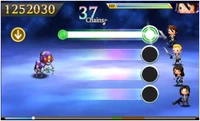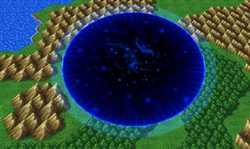
The Void's power.
The Void (無, Mu?, lit. Nothing) is a recurring theme in the Final Fantasy series. It can be taken in reference to either the physical phenomenon or the ideal of nothingness, though both tend to go hand-in-hand. In Dissidia Final Fantasy, several characters from different games speak of "The Void" as though it were the same dimension across all its appearances.
Nature
The Void, as it is referred to as an actual, physical area in space, often takes a form chosen by its "wielder" or current denizens, though it is often seen against a backdrop of pure darkness or celestial atmosphere. The term "Void" is also used in reference to the power to distort, or remove entirely, large parts of space. This is the most present form of the Void in the series.
In most, if not all, instances in which the Void is prevalent, so is the nihilistic attitude of those seeking to make use of its power. Often times this starts out as a simple desire for incredible power, but inevitably leads to an intense desire to reduce everything to a state of non-existence. Whether this is due to the fact the Void is an intelligent or sentient being, or if it is merely the result of gaining the state of being to make use of such power, is not known.
In Final Fantasy V it is told the Void existed before the world, and that the Crystals that sustain the planet of Final Fantasy V were born in the Void and thus created the world. From this it can be drawn that the Void is the original state of the universe from which all life has formed.
Appearances
Final Fantasy
Template:Sideicon While never mentioned by name in the original game, Dissidia Final Fantasy elaborates it was the Void that allowed Garland to time-travel to the past in order to become Chaos.
Dissidia 012 Final Fantasy somewhat retcons the idea that Garland became Chaos by explaining that the Chaos fought in Dissidia is a manikin, created by scientists from Onrac using crystal ore recovered on an expedition into the Void. The world of Dissidia, World B, is a near mirror image of the world of Final Fantasy, called World A, and lies on the edge of the Void.
Final Fantasy III
Template:Sideicon
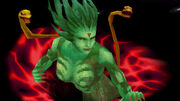
The Cloud of Darkness.
In Final Fantasy III, the Cloud of Darkness dwells in the World of Darkness and desires to use the power of the Void to reduce all existence to nothingness. The Warriors of the Dark that had been imprisoned within the Dark Crystals of the World of Darkness explain to the hero party that a delicate balance between the powers of Light and Darkness must be maintained in order to hold the Void at bay.
They go on to state that whenever an imbalance or "flood" of Light or Darkness occurs, the Cloud of Darkness appears to follow through with its plans. Whenever an imbalance occurs, four individuals are selected to become Warriors of Light or Darkness depending on the imbalance (i.e. Light Warriors against darkness, Dark Warriors against Light). To combat the Cloud of Darkness the Dark Warriors decide to aid the Light Warriors in the battle so their combined powers of Light and Darkness may overwhelm it.
Final Fantasy V
Template:Sideicon
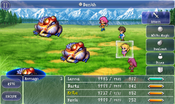
Banish in Final Fantasy V.
The Void is a prevalent term in the story. A thousand years before the game's events the two worlds had been one, but the world was split in two by the power of the Crystals after the necromancer Enuo was defeated and consumed by the Void. The Void itself was cast in the Interdimensional Rift, and the worlds split in two to seal the entrance to the Interdimensional Rift so no one could enter and take control of the Void's evil power again.
Exdeath destroys the Crystals and merges the worlds back together, releasing the Void so he may take control of it. Exdeath descends to the deepest sections of the Void and is able to control it and swallow several cities into nothingness. Once defeated by the Warriors of Light, Exdeath himself is consumed by the Void and re-manifests as Neo Exdeath. Once Neo Exdeath is killed, and the Crystals are restored from their broken shards, the Void seems to go into remission, and all the areas and people it had swallowed are restored.
In the Game Boy Advance remake, the final areas (at least) of the Sealed Temple, known collectively as the Lethe Court, are implied to be within the Void itself. The final room in this area (subtitled The Void) is where Enuo is fought.
Final Fantasy VIII
Template:Sideicon
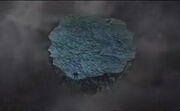
Squall, trapped within the temporal void.
There is a unnamed void where Squall Leonhart finds himself trapped after briefly traveling through time at the end of Final Fantasy VIII.
This void differs from the normal Void concept of the series in that the area appears to be outside of normal space-time continuum and presents itself as a barren desert with only a gray warping sky. Rather than being part of the more familiar Void concept, Squall is left in it because he is unable to focus on a place and time to return to where he felt he belonged due to his habit of leaving no attachments with those he encountered.
With no sense of belonging to or being attached to anywhere he became lost in time after the time compression restructured itself. As Squall traverses the landscape, gradually getting more tired, the land slowly disappears behind him until he becomes stranded on a small piece of land floating within the void. As his memories begin to be warped, he is saved by Rinoa Heartilly, who retrieves him and brings him back to his world.
Final Fantasy IX
Template:Sideicon
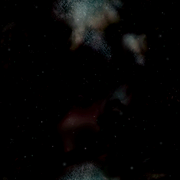
The black void between Memoria and Crystal World.
Although not directly referred to as the Void, Kuja deems everything unfit to live with his sudden knowledge of his limited life span, and goes out of his way to destroy the Crystal, which would revert everything to nothingness. This passion is also shared with Necron who has deemed life has no will to go on. Necron refers to the concept of a world with no life as the "zero world".
There is also a black Void-like area between Memoria and Crystal World that Zidane and his friends must cross to get to the beginning of all time, the Crystal. Going through Memoria is implied to be reaching back through time, until there is nothing but Void left, and the Crystal at the end of the Crystal World. This would comply with previous interpretations of the Void as the original state of the universe before the worlds were born.
Final Fantasy XI
Template:Sideicon While never called anything such, the Void is heavily referenced by the Chains of Promathia expansion in the form of the Emptiness, specifically the areas Promyvion and Apollyon. The Emptiness is a phenomenon that eats away at Vana'diel's five mothercrystals, which would eventually turn the world into nothingness, reflected in Promyvion as a pure black void with dusty, crumbling "islands" floating within it, inhabited by unworldly monsters composed of the remnants of the crystals' devoured memories. As a final reference, "true" Omega of Final Fantasy XI lies in wait as the final boss of Apollyon.
Final Fantasy XIII-2
Template:Sideicon
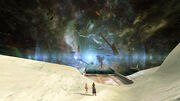
There is a location in Final Fantasy XIII-2 named The Void Beyond. Lightning says near the beginning of the game that Noel Kreiss "crossed the Void" to get to Valhalla. As said by Mog upon Serah and Noel's first visit the Void Beyond is a "shadow of Valhalla" that serves as a passage between the time gates. Time travelers run the risk of getting lost and appearing within this plane during their travels.
Paradoxes twist the timeline and may cause rifts in the time continuum. A Void-like area consumes portions of Oerba in 200 AF, which the player can fix by resolving the local anomalies in the Temporal Rift. There are also monsters that are trapped in the space between time, called the Rift; one such monster is the Gogmagog that appears in various time periods to challenge the player.
Final Fantasy XIV
Template:Sideicon The void is a generic term that inhabitants of Eorzea have given to a dark realm they believe exists beyond their own. When a creature is deemed to be too unnatural to be "of Eorzea" (such as ahrimans), they are often categorized as "voidsent", based on the common belief that they were sent by some sinister force from beyond the corporeal realm.
The void is also said to be the origin of the creatures present on the Dzemael Darkhold and the Thousand Maws of Toto-Rak. Upon advancing on the instances, some of the creatures will "retreat into the void", while others will emerge from it, effectively changing the monsters currently on the area.
Final Fantasy Dimensions
Template:Sideicon
The Void is briefly mentioned as a "space beyond space" that connects parallel universes. After the Warriors of Light and Darkness "defeat" the empty armor suit of the Avalonian Emperor, a rift opens leading them to the Void.
The Void houses the places engulfed on the Dimensional Shift that joined both worlds of Light and Darkness back into one, such as Castle Lux, Alfheim, Castle Burtgang, and Castle Falgabard, along with its inhabitants and lingering spirits. Deep inside is a force of nothingness known as Nil, which has the sole purpose of bringing everything back into nothingness. Nil created several deadly monsters that lurk within the Void known as the "Armies of Nil" of which the most powerful are the "Blades of Nil", which are the monsters Despair, Suffering, Anguish and Misery.
Despite being forces of nothingness, the Armies of Nil are sentient and seem to be negative on nature. This is further evidenced by how the Blades of Nil focus on stealing certain parts of humanity, such as Hope, Trust, Dreams, and Love. This makes it so far the only time in the series in which The Void behaves in a malignant manner.
Dissidia Final Fantasy
Template:Sideicon
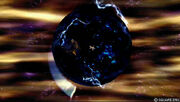
Exdeath's EX Burst consists of casting the Void on his opponent.
It is implied through the course of Shade Impulse that with Cosmos remaining dead, the imbalance of harmony and discord will cause the worlds to sink into the Void, along with the heroes and villains who had been summoned to fight.
Exdeath and the Cloud of Darkness retain their desires to return existence to the Void, and both sink into the Void when they are defeated for the last time. Dissidia also establishes, as mentioned above, that it is the power of the Void that allowed Garland to travel back in time in the original Final Fantasy.
Dissidia 012 Final Fantasy
Template:Sideicon

The rift to the Void from which the manikins emerge.
The Cloud of Darkness tells Laguna the manikins are cursed puppets that crept out of the Void from its rifts. The creation of a portal to the Void by Exdeath has allowed the Warriors of Chaos to summon the manikins as minions, allowing them to overwhelm the Warriors of Cosmos.
In the 12th cycle's final battle, Kain, Tifa, Laguna, Yuna, Vaan and Lightning locate this portal and sacrifice their lives to close it and stop more manikins from coming through. The gateways in World B are smaller portals to the Void that allow temporary travel to other worlds, which is why arenas from other Final Fantasy games manifest inside them.
The Reports further expand on the Void and how it connects the world of Dissidia to the world of Final Fantasy. A team of scientists from Onrac used crystal ore recovered from the Void to create the first manikins. Because they were mindless automatons, Cid of the Lufaine was recruited to endow a manikin with memories to give it a sense of self.
This manikin became Chaos, and was raised by Cid and his wife. Onrac eventually used Chaos as a tool of war and controlled him with a clone of Cid's wife, who would become Cosmos. When Cid and his wife attempted to rescue Chaos from Onrac, Cid's wife was injured and in his rage Chaos opened a portal to the Void, drawing himself, Cid and Cosmos to World B. Shinryu, a dragon that travels the Interdimensional Rift, visited World B, and the four entered a pact - Chaos and Cosmos would be made gods and summon warriors from the worlds connected to the Void to fight each other.
When one side lost, Shinryu would absorb the memories of the battle from them and grow stronger, imbuing Chaos with more power. Eventually Chaos would grow strong enough for him to open a portal to the Void again, and he, Cid and Cosmos would return to World A.
Theatrhythm Final Fantasy: Curtain Call
Final Fantasy Fables: Chocobo Tales
The void is mentioned in the Legend of the Crystals story. It is the emptiness that existed before the universe was created. It was ruled over by the "dark monarch". After endless cycles, the creator and four crystals emerged in fear of the darkness and created the world.
Etymology
There are a few different origins where the concept of the Void in the Final Fantasy series may have derived influence. In astronomy, voids are the empty spaces between filaments, which contain very few or no galaxies. Vacuum, a space empty of matter, can also be referred to as a void. These interpretations of the word "void" can be similar to the Void's representation in some installments of the Final Fantasy series as a vast emptiness.
In Japanese philosophy 空 kū or sora, most often translated as "Void", but also meaning "sky" or "heaven", represents things beyond everyday human experience, particularly things composed of pure energy. Bodily, kū represents spirit, thought, and creative energy. In martial arts, particularly in fictional tales where the fighting discipline is blended with magic or the occult, one often invokes the power of the Void to connect to the quintessential creative energy of the world. In the Final Fantasy series, villains, notably Exdeath in Final Fantasy V, have tried utilizing the power of the Void for their own ends.
The term void can also refer to a Buddhist philosophical concept, the theme of emptiness (śūnyatā) that emerged from the Buddhist doctrines of the nonexistence of the self and dependent origination, but the exact definition and extent of emptiness varies from one Buddhist tradition to another.
Template:Miscellaneous

